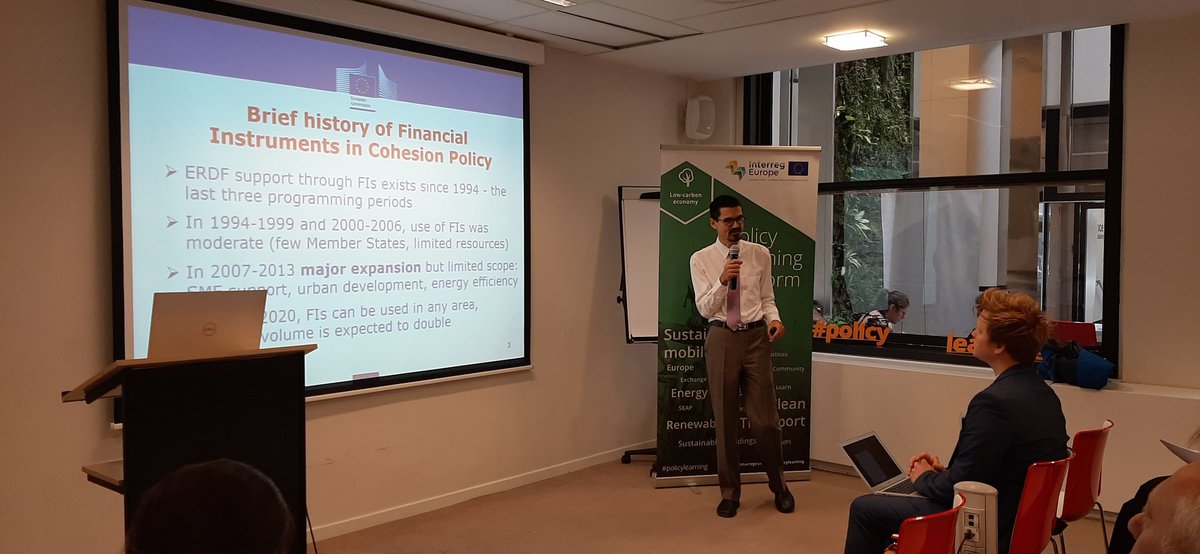
MENU

20 Jun 2019
20 Jun 2019

Thank you very much for your participation in this workshop. We greatly appreciated your input and hope that you found it a great learning and exchanging experience.
In case you were unable to come, below you will find all the presentations that were held throughout the workshop. The Policy Learning Platform experts created a follow up brief in which you find highlights, good practices and the recommendations and materials for future steps.
The morning was kicked off with an introductory presentation by the Low-carbon economy expert Katharina Krell from the Policy Learning Platform.
Adam Abdulwahab from the European Commission followed up. Throughout his presentation he set the general framework for the workshop, gave a brief history of financial instruments in cohesion policy and outlined the key advantages of the European Structural and Investment Fund.

In order to get a better understanding of financial instruments and how to establish them, Françoise Réfabert from Energies Demain, explained how to applicate the financing of refurbishement of private homes. Discover more in her presentation. Later during the workshop, she complemented her first presentation with a brief follow up.
Nicolas Stancioff presented how Latvia deals with Energy Efficiency as part of the Building and Energy Conservation Bureau. Find out more about the Latvian Baltic Energy Efficiency Facility (LABEEF) in his presentation.
Elodie Denizart representing the Région Hauts-de-France presented the Picardie Pass Rénovation business model, its challenges and the benefits reached so far. Find out more about the Pass Rénovation in her presentation.
This was follow up by Jiří Peterka, Operator ICT of the City of Prague. He explained how they are envisioning Smart Prague and how they are working towards a better quality of life in a prospering city thanks to the active use of modern technologies. Find out more about the technologies Prague is using.
Alexandra Lopes, management body of the IFRRU project presented how they used a Financial Instrument for Urban Rehabilitation and Revitalization. Discover how the financial instrument was established in her presentation.
The presentation of Nathanaël Hance from Bruxelles Environnement pointed out how Brussels promotes and supports Energy Renovations, with citizens as a target group. Find practical examples and the outcomes in his presentation.
The following presentations that were given revolved around the topic of own revolving fund. Tommy Lindström from the Energy Agency for Southeast Sweden presented how the EPC model was used to contribute to a ecological and sustainable municipality.
Finally, the morning session ended with a presentation from Annelii Ausmees from KredEX. KredEx helps people to improve their living conditions, by offering them e.g. loans, guarantees and grants for solutions aimed at energy efficiency. Disover everything they offer in the presentation.
During the afternoon sessions, Anette Jahn from H2020 Energy presented more about Horizon 2020 funding and experience from projects at EASME.
Robert Pernetta followed up on this with a presentation on the European Investment Bank and ELENA support. He pointed our that fi-compass is a very useful tool if you are searching for advisory services for financial instruments for European Structural and Investment fund.
The workshop was closed by the experts of the Policy Learning Platform. Previous activities and upcoming activities can be found in this presentation.
Find the highlights, the good practices and the policy recommendations that were shared and discussed during the workshop in this follow up brief prepared by the experts of the Policy Learning Platform.
Interested in learning more about the Financial Instruments for the low-carbon economy?
Discover our policy briefs in the knowledge hub or get in contact with us through the expert support helpdesk.